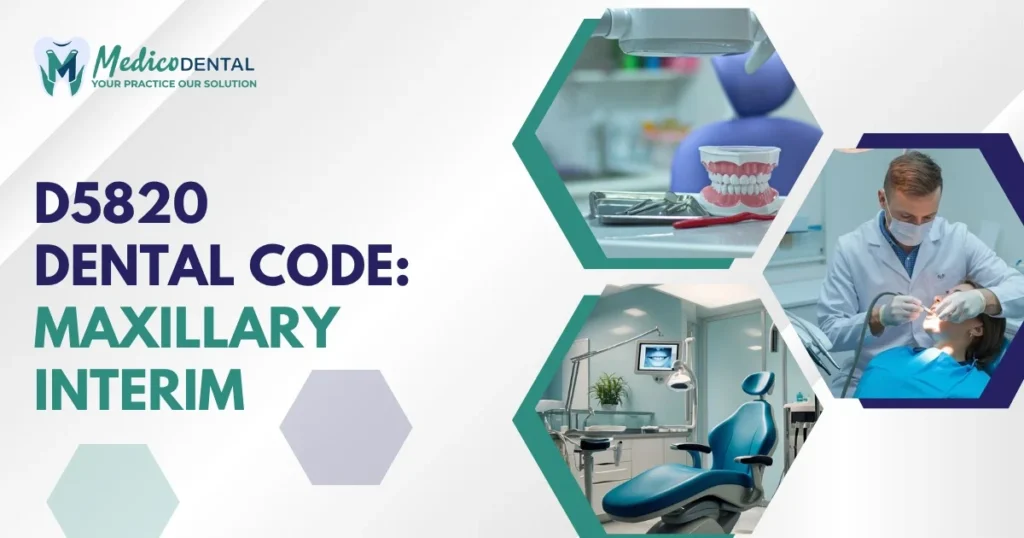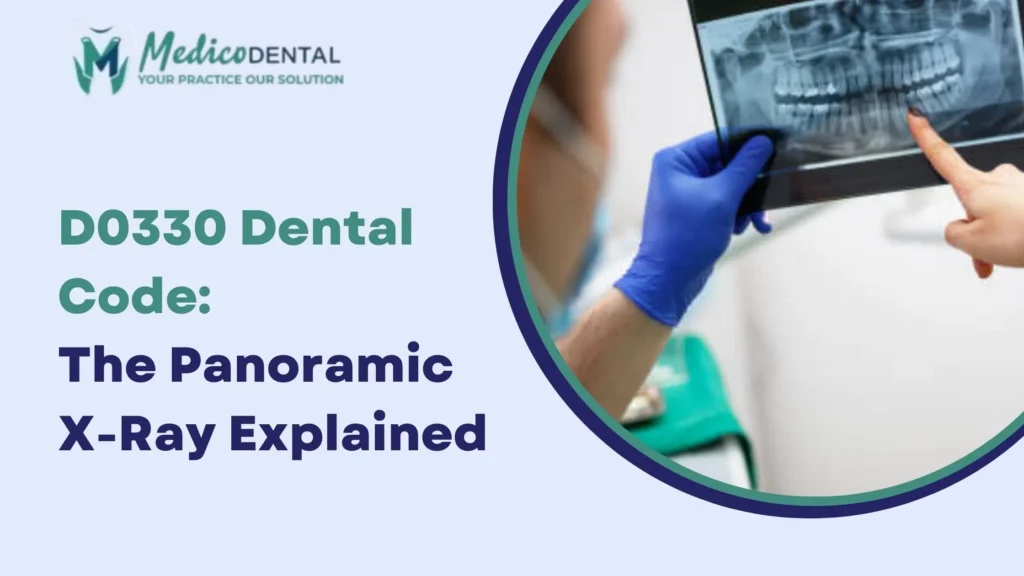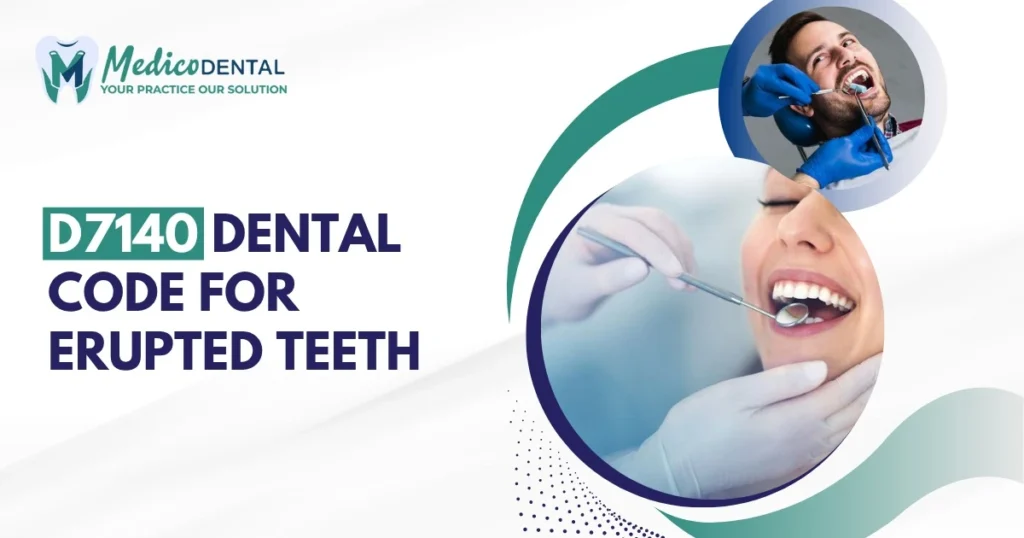A confident smile is more than just an aesthetic feature it reflects health, comfort, and self assurance. For patients who have lost some teeth in their upper jaw, an interim partial denture can be an essential temporary solution while awaiting permanent restorative work. The D5820 dental code represents this specific dental service, helping providers and insurance companies identify, bill, and document the procedure correctly. Understanding this code ensures that both patients and dental professionals are clear about its purpose, process, and coverage.
What Is the D5820 Dental Code?
The D5820 dental code is part of the Current Dental Terminology (CDT) system, established by the American Dental Association (ADA). This code specifically refers to an interim partial denture for the maxillary (upper) arch. The term “interim” signifies that it’s a temporary dental appliance designed to restore aesthetics and basic function while the patient waits for a more permanent solution such as a cast metal partial denture or implant supported prosthesis.
An interim partial denture fabricated under D5820 typically includes:
- Retentive clasping materials
- Rests
- Artificial teeth
This type of denture allows patients to speak and chew comfortably and prevents neighboring teeth from shifting into the empty spaces.
Overview of Interim Partial Dentures
An interim partial denture is lightweight and removable, offering flexibility during the healing phase after extractions or surgical procedures. Dentists often recommend it for patients who are not ready for final prosthetics due to ongoing treatment, tissue healing, or financial planning. Though temporary, these dentures play a critical role in maintaining oral structure and aesthetics during the transition period.
Purpose of the D5820 Dental Code
The D5820 dental code serves several important purposes in both clinical care and dental billing. From a patient’s perspective, it ensures continuity of function and appearance while waiting for a final restoration. From a provider’s perspective, it clarifies the nature of the service being rendered, making documentation and insurance claims smoother.
Why Interim Partial Dentures Are Used
Interim partial dentures serve as temporary replacements for missing teeth to preserve oral health and confidence. They help patients adapt to dentures before receiving a permanent set and prevent changes in bite alignment caused by shifting teeth.
Common Clinical Scenarios for This Procedure:
- After tooth extractions where healing time is needed before permanent restoration
- Following oral surgery or trauma involving tooth loss
- When immediate aesthetics are desired before final dentures are made
- During phased treatment plans involving implants or bridges
These situations make the D5820 code particularly useful for patients transitioning between restorative stages of treatment.
Step by Step Procedure for D5820 Dental Code
The creation and placement of an interim partial denture involve several precise steps that ensure a comfortable and functional temporary fit. Each phase contributes to the overall success of the prosthesis.
Impressions and Mold Creation
The process begins with the dentist taking detailed impressions of the patient’s upper jaw. These impressions capture the structure of the teeth and gums, helping the dental laboratory create an accurate model.
Fabrication of the Interim Denture
Using the impression, a dental technician fabricates the interim denture on a stone cast. The materials used are typically acrylic, designed for short term durability and ease of adjustment. Artificial teeth are selected to match the patient’s natural shade and shape as closely as possible.
Fitting and Adjustments
Once the denture is ready, the dentist places it in the patient’s mouth to evaluate comfort, bite alignment, and aesthetics. Minor adjustments are made to ensure proper fit and prevent irritation. Patients are advised on care, cleaning, and how to adapt to wearing the appliance daily.
This process ensures that the interim partial denture fulfills its purpose of restoring essential function and appearance while waiting for permanent treatment.
Insurance Coverage for D5820 Dental Code
Insurance coverage for the D5820 dental code varies depending on the patient’s dental plan and carrier. Generally, coverage is approved when the interim denture is deemed medically necessary, such as following extractions or as part of a phased treatment plan.
When Dental Plans Cover the Procedure
Many insurance providers recognize D5820 as a covered benefit when it’s required to maintain oral health or aesthetics during healing or treatment. However, plans may limit the frequency of coverage or exclude it if considered a temporary cosmetic option.
Coverage Criteria Often Include:
- Tooth extractions resulting in gaps
- Preparation for permanent dentures
- Post surgical healing periods
- Transitional phases of dental rehabilitation
Documentation Requirements for Reimbursement
To ensure successful claim approval, providers must submit proper documentation, including:
- Detailed clinical notes describing the need for an interim denture
- Evidence of extractions or planned restorative procedures
- Photographs or radiographs if required by the insurer
Accurate coding and thorough recordkeeping reduce the risk of claim denials and help patients receive the benefits they deserve.
D5820 vs D5821: Upper and Lower Interim Partial Dentures
While D5820 refers to the maxillary (upper) interim partial denture, its companion code, D5821, designates the mandibular (lower) version. Both codes describe the same type of temporary prosthesis but correspond to different arches of the mouth.
Difference Between Maxillary and Mandibular Interim Dentures
- D5820: Used for the upper jaw (maxillary arch)
- D5821: Used for the lower jaw (mandibular arch)
- Primary distinction: anatomical fit and the direction of placement
Each denture is custom made to accommodate the unique structure of the patient’s mouth, ensuring a secure fit and balanced function.
When Each Code Is Used
A dentist will select D5820 or D5821 based on which arch requires the temporary restoration. In some cases, both may be billed together if interim partial dentures are needed for both arches simultaneously.
Understanding the difference between these codes ensures proper billing accuracy, avoiding claim rejections and helping maintain compliance with CDT coding standards.
Duration and Limitations of D5820 Interim Partial Dentures
An interim partial denture under the D5820 dental code is designed as a temporary restoration, typically lasting three to six months, depending on the patient’s oral condition and healing process. However, this duration can vary based on the type of materials used, the extent of bone and gum healing, and how well the patient follows aftercare instructions.
How Long an Interim Denture Lasts
These dentures are made from acrylic materials, which are less durable than the metal frameworks used in permanent prostheses. Over time, wear and tear, chewing pressure, and natural oral changes can affect the fit and comfort of the denture. Dentists closely monitor these changes and may adjust or reline the appliance to extend its usability during the interim phase.
Reasons for Replacement
Several factors can lead to the replacement of a D5820 interim partial denture, such as:
- Changes in gum tissue or bone structure after extractions
- Fracture or distortion of the denture base
- Staining, odor, or excessive wear
- Preparation for a permanent restoration
Transition to Permanent Prosthesis
Once the patient’s gums and bone have stabilized, the interim partial denture is replaced with a definitive prosthesis, such as a cast metal partial, complete denture, or implant supported solution. This transition ensures a long lasting and natural looking restoration.
Factors Associated with the D5820 Dental Code
The factors associated with the D5820 dental code refer to the various clinical, financial, and procedural elements that influence how this code is applied, billed, and interpreted in dental care. The D5820 code specifically represents an interim partial denture for the maxillary (upper) arch, but several underlying factors determine its use and cost.
Variables That Influence Total Cost
Several factors determine the final cost:
- Number of teeth being replaced
- Complexity of the patient’s oral condition
- Dentist’s expertise and lab fees
- Additional procedures (extractions, impressions, relines)
Tips for Cost Transparency and Estimates
To ensure clarity and avoid financial surprises, patients should:
- Request a written treatment plan with itemized costs
- Ask about insurance coverage for code D5820
- Discuss any potential adjustments or relines that might add to the total fee
Open communication between the patient and dental provider promotes transparency and helps set realistic financial expectations.
Clinical Considerations and Aftercare
Even though interim partial dentures are temporary, they require proper care and maintenance to ensure comfort, hygiene, and longevity. A well maintained denture can function effectively throughout the healing period without causing irritation or infection.
Proper Cleaning and Maintenance
Patients should clean the interim denture daily using mild soap or denture cleanser and a soft brush. Hot water should be avoided as it can warp the acrylic base. Overnight soaking in a denture solution helps keep it fresh and disinfected.
Common Adjustments or Follow Ups
As the gums heal or shrink after extractions, the denture may loosen or cause minor discomfort. Dentists often perform adjustments or relines to restore a secure fit. Regular follow up visits allow early detection of any issues that could compromise comfort or healing.
Preventing Complications
Maintaining good oral hygiene is vital. Food debris and plaque can accumulate under the denture, increasing the risk of infection or inflammation. Patients should also remove the denture at night to allow gum tissues to rest and recover naturally.
Dentist and Laboratory Roles in the D5820 Process
The success of a D5820 interim partial denture depends on seamless collaboration between the dentist and the dental laboratory. Each plays a distinct but interconnected role in creating a well fitting and natural looking restoration.
Collaboration Between Dentist and Dental Lab
The dentist begins by taking accurate impressions of the upper arch and specifying design details. These impressions are then sent to the dental laboratory, where technicians use specialized materials and techniques to fabricate the denture according to the patient’s anatomy.
Materials Used and Fabrication Techniques
Typically, acrylic resin is used for interim dentures due to its affordability, light weight, and adaptability. The lab technicians may reinforce the denture with wire or clasping elements for additional stability. The collaboration ensures that the final product fits precisely, functions properly, and matches the patient’s aesthetic needs.
Patient Education: What to Expect with a D5820 Interim Partial Denture
Understanding what to expect can make the adjustment process smoother for patients receiving a D5820 interim partial denture. While it may take time to adapt, most patients quickly adjust with proper guidance and care.
Comfort and Adaptation Period
It’s normal for patients to experience mild discomfort or speech difficulty during the initial days. With regular wear, the mouth adjusts, and comfort improves significantly. The dentist may schedule follow ups to ensure that no sore spots develop.
Dietary and Oral Hygiene Advice
Patients should begin with soft foods and gradually return to a normal diet as they adapt. Avoiding sticky or hard foods helps prevent dislodging the denture. Brushing remaining natural teeth and gums daily is critical to maintaining oral health.
Expected Outcomes
With proper use, the interim partial denture allows patients to smile, chew, and speak naturally during the transition period. It also preserves facial appearance and prevents teeth from drifting out of place.
Coding and Documentation Tips for Dental Professionals
Accurate documentation and coding are essential for claim acceptance and compliance with dental billing standards. The D5820 dental code should be used exclusively for interim partial dentures of the maxillary arch.
Importance of Accurate D5820 Coding
Proper coding ensures that insurance companies correctly recognize the procedure and reimburse appropriately. Incorrect coding can delay claims or lead to denials.
Common Billing Errors to Avoid:
- Using D5820 for a permanent denture
- Failing to specify that the prosthesis is “interim”
- Not providing adequate clinical justification for medical necessity
ICD 10 Linkage and Claim Submission Tips
Linking the CDT code with the appropriate ICD 10 diagnosis codes (e.g., K08.101 for partial edentulism) strengthens claim validity. Documentation should include clinical notes, treatment plans, and any supporting images or models. Clear, consistent paperwork minimizes administrative delays.
Conclusion
The D5820 dental code represents more than a dental billing identifier it reflects an important stage in restorative care. Interim partial dentures provide patients with comfort, aesthetics, and functionality during the waiting period before permanent restoration. By understanding the duration, cost, aftercare, and proper documentation associated with this procedure, both patients and dental professionals can ensure a smooth, efficient, and positive treatment experience. Consulting with a qualified dentist remains the best way to determine the right timeline and options for achieving a lasting, confident smile.
FAQs
What does the D5820 dental code represent?
Ans. It refers to an interim partial denture for the upper (maxillary) arch, serving as a temporary tooth replacement.
How long does a D5820 interim partial denture last?
Ans. It typically lasts around three to six months, depending on healing and material quality.
Is the D5820 procedure covered by dental insurance?
Ans. Yes, most plans cover it when medically necessary, especially after extractions or surgery.
What is the difference between D5820 and D5821?
Ans. D5820 is for the upper jaw, while D5821 is for the lower jaw interim partial denture.



